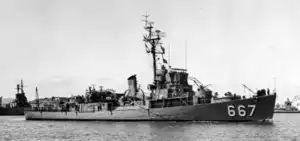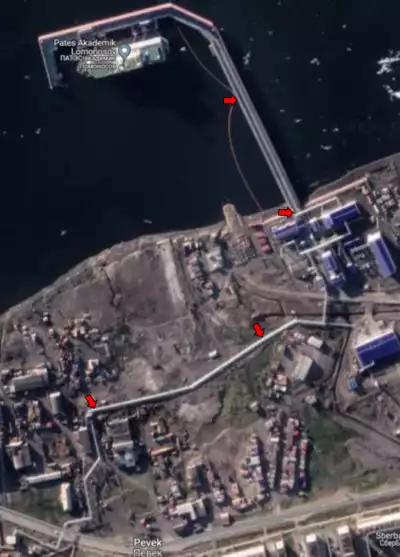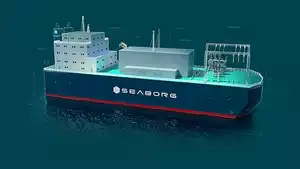by Ed Sawicki
May 2021, updated 2024
Power plants mounted on barges can provide power to cities during emergencies or to get around obstacles to the installation of land-based power plants. The concept is not new—it was first done in 1929 to solve a power emergency in Tacoma, Washington and numerous times afterward.

On September 6, 2017, Category 5 Hurricane Irma crossed Puerto Rico cutting power to about two-thirds of the island. Two weeks later on September 20, Hurricane Maria also crossed the island with winds of up to 155 mph. Virtually all electric power was gone. It would not be restored for nearly one year.
The Trump Administration resisted giving Puerto Rico significant help beyond the rolls of paper towels the president threw to a crowd during his visit to San Juan. Area hospitals were without power for days until emergency generators were brought in.
This article will look at how power emergencies like this could be better handled in the future by using marine power plants.
USS Lexington powers Tacoma

In December 1929, Tacoma, Washington was suffering a power shortage. Much of its power was hydroelectric that relied on enough rain and snowpack. A drought during the summer and fall caused low water levels in the Lake Cushman reservoir.
Their power-sharing agreement with neighboring Seattle could not solve the problem. The city placed restrictions on electricity use. Cascade Paper Company cut back on production and had to lay off most of its work force.
Tacoma officials asked president Herbert Hoover for help. This resulted in the U.S. Navy offering to help by having the USS Lexington (CV-2) dock in Tacoma and connect its power plant to Tacoma's power grid. From its berth at Baker Dock at Point Ruston, the Lexington tied in to the city's power lines through massive transformers mounted on flatbed rail cars.
Unlike more traditional ships at the time, the Lexington used electric motors to drive its propellors. So, its steam turbines generated electricity rather than turn the propellors directly. Its four steam turbines supplied a total of 140 megawatts of power—about one-quarter of Tacoma's power needs for about 30 days—enough time for the Lake Cushman reservoir water levels to normalize.
The local power providers were not happy with the Navy (the government) stepping in to solve their power problem, but the citizens of Tacoma were delighted. There were brass bands and celebrations.
The Lexington was noteworthy for being the first marine platform to provide substantial power to a city by sailing into its port and connecting to its power grid.
U.S. Navy Turbo-Electric Generators

Due to the success of the Lexington supplying power to Tacoma, the Navy converted several ships into Turbo-Electric Generators (TEG) specifically for the purpose of providing electrical power to shore facilities. These were:
- USS Donnell (DE-56) IX-182 barge
- USS Foss (DE-59)
- USS Whitehurst (DE-634)
- USS Wiseman (DE-667)
- USS Marsh (DE-699)
- Hotham (K-583 ex-DE-574)
The USS Donnell was damaged during escort duty in the North Atlantic. It was converted to a power barge and towed to Cherbourg-Octeville, France to supply power.
During the winter of 1947-48, the destroyer USS Foss (DE-59) provided power to Portland, Maine, also because of lack of rain. The USS Marsh was converted to a power unit in September 1945 and powered Guam for three months, followed by Kwajalein six months later. In 1950, Marsh provided power to Pusan, South Korea.
These ships provided 450 volts 3-phase at 400 amps maximum. The USS Wiseman was unique among these ships because it's propulsion used electric motors. So, propulsion power, or a portion of it, can be redirected to other systems.
MH-1A Sturgis

Another water shortage occurred in 1968, in the Panama Canal Zone. The Gatun Hydroelectric Station had to be shutdown because of low water levels of Gatun Lake. This time, it was the U.S. Army that sent emergency power but, unlike the 30 days in Tacoma, the Army powered the area for four years.
The Army had mounted a nuclear reactor, called the MH-1, on the hull of the WW2-era Liberty ship SS Charles H. Cugle. Since the Cugle no longer had operable engines, it had to be towed and was technically a barge. This combination of reactor and barge was named the MH-1A or Sturgis.
The MH-1A Sturgis was the world's first floating nuclear power plant. It's reactor provided 10 MW of electric power—a small amount of power for a nuclear reactor by today's standards—but it illustrated the benefits of sailing a reactor to a trouble spot. Barge-mounted nuclear reactors would become popular decades later.
Russian nuclear barges

In 2019, a Russian nuclear barge named the Akademik Lomonosov was docked at Pevek in northeastern Russia. Unlike the U.S. ships mentioned above, its assignment is not temporary. It is permanently assigned to providing power to Pevek and the surrounding area.
The benefit of the barge is transportation. There are no adequate roads or rail to Pevel.
It is equipped with two 35 MW pressurized water reactors for a total of 70 MW that is used by the regional
Chaun-Bilibino power system. The barge replaces the Bilibino Nuclear Power Plant.

The reactors also produce 300 MW of thermal energy that supplies heat to Pevek, reducing the pollution caused by previous methods of heating. In the aerial photo, the red arrows point to the piping used to provide heat to buildings in the city.
In August 2023, construction began on the first of four barges that will each be fitted with two 200 MW reactors. These will power the mining projects in the Chukotka Autonomous Region in northeast Siberia. The Baimskaya Area is rich with 2.5 billion tonnes of mineral resources, including 9.9 million tonnes of copper and 16.6 million ounces of gold. Electric power is needed to harvest those minerals.
A road and transmission line will be built to connect the mining area to a new port facility that will be built at Cape Nagloynyn. The new port is about 50 miles southwest of Pevek, where the Akademik Lomonosov is located.
Russian company Rosatom is the owner of these barges and is looking to mass produce these barges for foreign markets.
NOTE: Several articles describe the Akademik Lomonosov as the “world's first floating nuclear power plant” Clearly, that's not the case. The MH-1A Sturgis was the first.
Chinese nuclear barges

Like the Russians, the Chinese are building nuclear barges for their own use initially and plan to export them later. China's reactors are low-power, targeted to applications like powering oil rigs and small islands, such as their disputed Spratley Islands in the South China Sea.
The engineering team designing the barge want it to continue providing power during severe storm conditions, and to not capsize under any conditions. It should survive conditions that caused the Fukushima Daiichi disaster.
Liquid fuel nuclear barges
Two projects now, and likely more in the future, are working towards placing Molten Salt Reactors (MSRs) on barges. MSRs have numerous benefits over more traditional reactors, such as increased safety and simplicity. In MSRs, the molten salt is both the fuel and the coolant. In MSR training classes, students hear, “You can't have a core meltdown when the core is already melted (molten).”
MSRs operate at high temperatures but low pressures, thus not requiring the large containment vessels you're accustomed to seeing with more traditional reactor designs. This allows for far smaller reactors.
In December 2022, Bureau Veritas and ThorCon teamed up to offer such barges in Indonesia first, and other countries in Southeast Asia later.

Danish company Seaborg has teamed up with South Korea’s Samsung Heavy Industries to offer nuclear barges that are also based on molten salt reactors. Named the CMSR Power Barge, they are modular and can produce from 200 to 800 MW of electricity.
Sources
Wikipedia: Puerto Rico Electric Power Authority
Army Nuclear Power Program - MH-1A Sturgis
U.S.S. Lexington provides electricity to Tacoma beginning about on December 17, 1929.
Russian floating nuclear power station
Wikipedia: SS Charles H. Cugle
YouTube: MH-1A STURGIS Construction Report
YouTube: MH-1A STURGIS Dockside Testing Report
Wikipedia: Nuclear marine propulsion